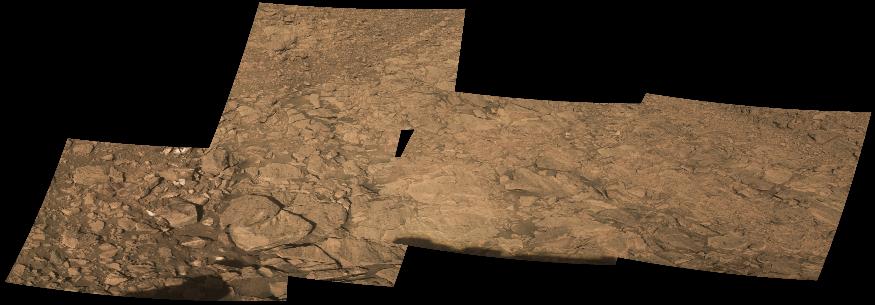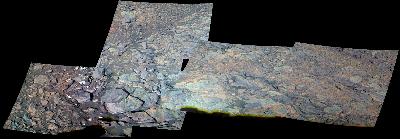La Bajada South
This mosaic was acquired by the Mars Exploration Rover Opportunity from Sols 4878-4882 (October 13-17, 2017). About 62 degrees across at the widest point, the view in this mosaic acquired by the Mars Exploration Rover Opportunity is of a rock target named La Bajada where there is evidence of abrasion by wind-driven sand blowing upslope from the interior of Endeavor Crater. It is thought that the white bits of exposed rock seen in the bottom left frame might be due to the rover wheels scraping the surface of the rocks.
The rover team's winter strategy for Opportunity was to stop at north-facing locations between drives no longer than 20 meters (about 66 feet), which the team calls "lily pads", to make sure Opportunity could gather enough solar power to stay alive and keep moving through her eighth Martian winter. La Bajada was the rover's third lily pad inside of Perseverance Valley. More information about La Bajada can be found at the public release of the northern La Bajada outcropping in color. The southern outcrop of La Bajada was imaged twice: once from Sols 4878-4882 (October 13-18, 2017) displayed above here, and later on Sol 4884 (October 20, 2017) at a different viewing perspective showing more of the surrounding rocky terrain. The northern outcrop and stereo anaglyph were imaged separately to conserve rover power during the winter.
NOTE: Missing data and other artifacts in this mosaic are the result of the images being acquired while the Opportunity rover was operating in "RAM mode". That is, because of issues with the rover's onboard Flash memory storage, sometimes data are stored directly in the rover's volatile RAM memory instead, and then downlinked to Earth. At the end of each sol of RAM mode operations, however, when the rover shuts down, all of that sol's data is erased. Thus, any missing images, missing color channels, or data transmission errors cannot be fixed by retransmitting the missing data the following sol, like we can do during Flash mode operations.
Pancam's 753 nm, 535 nm, and 432 nm filters were used in making this mosaic. Two versions are provided at full resolution: an approximate true color rendering, and a false color rendering which enhances the subtle color differences in the scene.
Jim Bell
Pancam Instrument Lead
February 28, 2018
|
|


